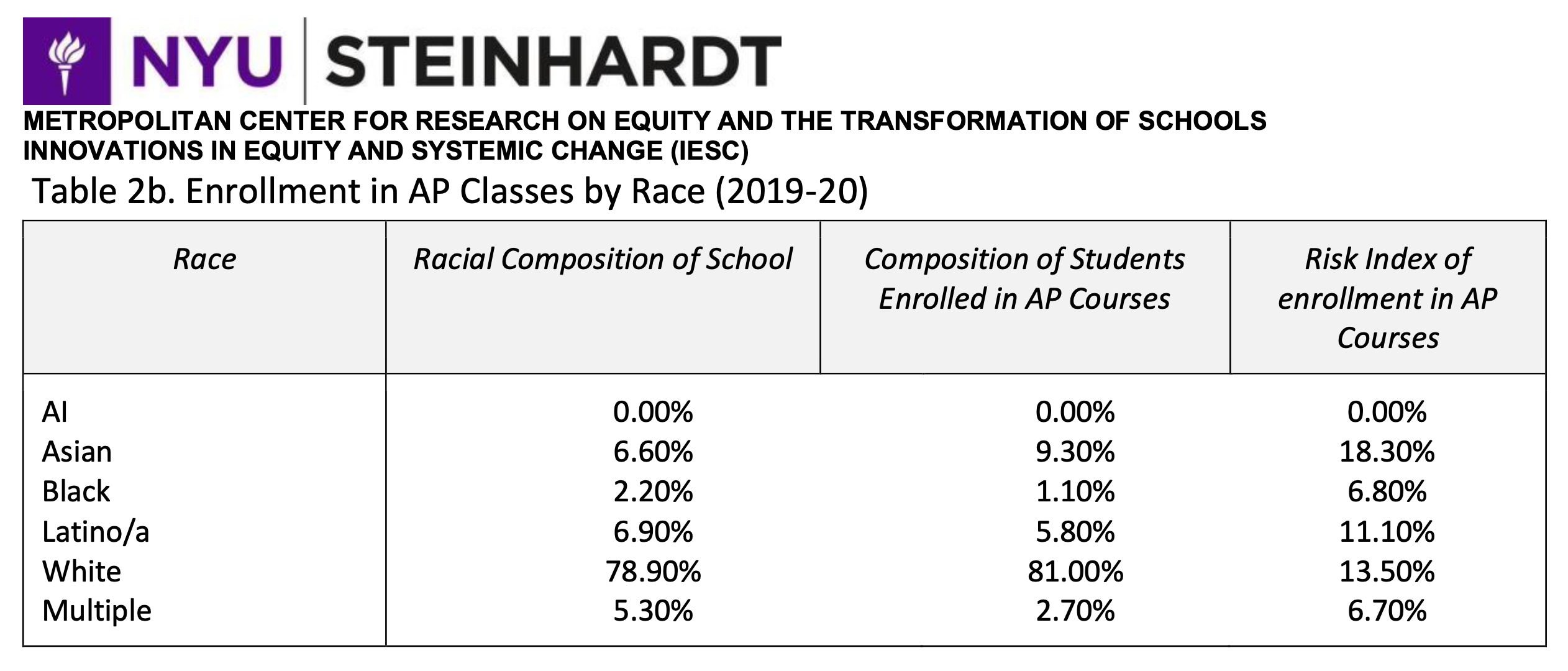NYU Metro equity study report targets Asian student achievement in Westport schools
T he much-anticipated report from NYU Metro Center, the consulting firm retained by Westport Public Schools to conduct an equity study, has finally been released. The report will be addressed by the administration on Monday, April 25, 2022, at Staples High School at 7PM.
Although the report is short on specific concrete action steps (other than an apparent suggestion to continue to “invest” in NYU Metro for future consulting services), the dominant theme of the document is that “disproportionality” pervades Westport schools. Among the most important contentions of the study is that certain racial/ethnic groups are “overrepresented” when it comes to AP/honors classes, special education programs and disciplinary procedures, while others are “underrepresented.”
There is a great deal to criticize in this report, but we will focus at this time on one topic in particular: the potential implications for Westport’s Asian student population, where the most significant “disproportionalities” were observed. NYU Metro has a track record of making recommendations that are harmful to Asian children; this pattern of anti-Asian racial animus continues in Westport.
With respect to how Asian students are treated in the equity study report, we seek to make four major observations:
-
The equity study exemplifies the flawed and dangerous logic of contemporary antiracism whereby disparate outcomes necessarily indicate a biased and corrupt process.
A major focus of the report was the observation that whites and Asians are disproportionately represented in honors and AP classes. This is presented as ipso facto proof of some kind of “inequitable” and improper selection process. According to the logic of the report, if there are racial/ethnic disparities in certain programs (for example, the percentage of Asian students in AP classes exceeding the percentage of Asian students in the general student population), something improper is happening. There is by definition some kind of explicit or implicit racist procedure at work to produce this outcome.
However, no evidence is presented in the report that WPS professionals are deliberately or negligently favoring Asian or white students for advanced courses, rather than using objective standards. Some of the alleged disproportionalities are in fact quite small, which raises questions of statistical significance. It is wrong to insinuate, based on racial composition data alone, that any Westport Public School employee is knowingly or unknowingly participating in some form of racial discrimination.
-
The flawed logic of disproportionality is especially threatening to Asian students.
Based on the data presented, the Asian student demographic is where we find the widest disparities. The study notes that in 2019-2020, Asians were disproportionately represented in AP classes by 2.7% (9.3% - 6.6%). This exceeds the disparity found among any other group, despite the fact that Asian students are a relatively small proportion of the total school population.

As a consequence, if one were to try to bring the Asian AP representation in line with the school average, we would need about a 30 percent reduction in the number of Asian students participating in AP classes. By contrast, to bring the white AP representation in line with the school average, we would only need an approximately 3 percent reduction in the number of white students participating in AP classes. Given that the presence of racial disparities in AP classes is viewed as a problem that needs fixing, it is clear that the risk of Asian students becoming targeted for exclusion from AP classes in order to achieve the desired racial composition is especially high. An Asian student would in fact be at ten times higher risk than a white student of being culled from AP courses, to the extent perfect proportionality with the broader student population became an objective of the school system.
-
It is absurd and offensive to suggest that Asian students are disproportionately represented in AP/honors classes because of some kind of corrupt or improper selection process.
Asian-Americans objectively perform well across American society. Approximately 26 percent of Harvard’s class of 2025 is reported to be Asian, while Asians are only about 7 percent of the US population. Asians have higher average incomes than the broader US population and the white population.
To assert without evidence that Asian success, in Westport schools or elsewhere, is unjust and a result of some kind of systemic favoritism is frankly an extraordinarily racist proposition. This is, however, a clear implication of the NYU report, which refers to Asians as being “overrepresented” in AP classes (page 20). It is extremely disappointing that Westport Public Schools are willing to endorse the idea that there are in effect too many Asian students in AP classes by disseminating this report. The only scenario where Asian students would be “overrepresented” would be a scenario where they were the beneficiaries of racial favoritism—but there was not a shred of evidence presented in support of that claim.
To fully appreciate how egregious the claim of Asian overrepresentation is, imagine if the report stated that Jewish students were “overrepresented” in AP classes at Staples. There would be an immediate (and justifiable) uproar within the community. Would Westport’s sizeable Jewish population accept the implication that there are too many Jewish students in AP classes? And that this can only be explained as an unjust manifestation of conscious or unconscious bias within the administration and faculty, who now need to be trained by NYU Metro so those numbers come down? How is it acceptable then to make such a statement with regard to Asian students?
-
The NYU equity study report establishes discriminatory intent and sets the stage for anti-discrimination litigation against Westport schools.
By distributing and implicitly endorsing the NYU Metro equity study report, the administration has rendered Westport Public Schools vulnerable to litigation by parents of Asian students and potentially other groups. All of our children have a Constitutional right to attend public school without any threat of racial discrimination or segregation. Any child, regardless of racial background, deserves the same opportunity to take advanced courses, to benefit from special education resources, and to participate in any other educational offering. The methodology of disproportionality sets the stage for racial quotas, which would represent a gross violation of our children’s civil rights. Going forward, parents of Asian students who find their child discouraged from taking AP courses, or on the flip side being recommended for special education programs, will rightly question the motivations of the decision-maker, who may be under pressure to correct perceived disparities in these classes.
Westport’s association with NYU Metro has been a complete fiasco. One can only hope the dissemination of this report marks the end of our involvement with that group. Westport as a community aims to become more welcoming from a diversity perspective. Asians are the largest non-white racial group in our town, and Asian families continue to move here. Asian success in Westport should be celebrated, not characterized as a problem that requires intervention.
On Monday evening, the Board of Education should make a statement distancing itself from this report, its methodology and findings.
